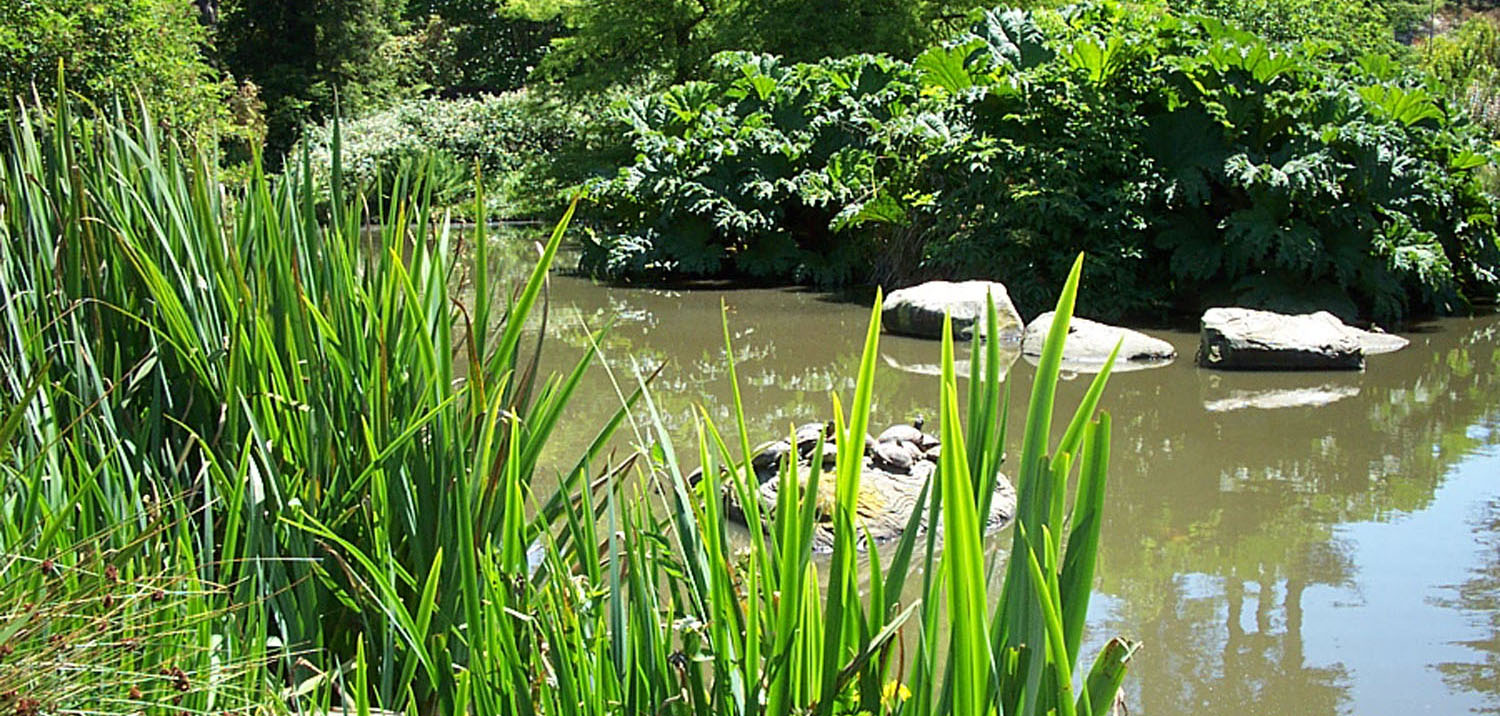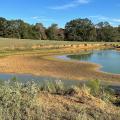Creating Water Features in the Landscape

The simple addition of water in the landscape can offer a new dynamic to a garden area.
From quiet still shallow ponds to the active spray jets in a formal pool, water can provide just the right element for the many moods of a landscaped space. Because of the wide range of options that are available, adding a water feature can be accomplished for even the smallest of garden areas.
How Water Gardens Work
Water gardens can range in size from a pond of several acres to a small whiskey barrel container. Although different in water volumes, the principles of water gardening are the same for any size feature. Every water garden will need to be maintained on a regular basis and consideration should be made for the amount of time available by the homeowner. By understanding a few basic principles, problems in ponds can be reduced and maintenance minimized.
Water Chemistry
A healthy water body is one that is in balance. Water is the substance where many organisms live, from small algae and microorganisms to higher water plants. These in turn support aquatic insects, amphibians and reptiles, and fish. When all these elements are in balance according to the water volume a healthy ecosystem is achieved. Imbalance occurs when too much of one thing is added to an aquatic system.
Water bodies are contained systems and are often sinks, or places where nutrients and debris are deposited. For example, if a pond is placed at the bottom of a hill; then soil, rainwater, leaves, and fertilizers can wash into the pond. If too many of these elements exceed the capacity of the pond, problems can occur. In general, the larger the water body, the better its ability to buffer or handle larger amounts of input.
Smaller ponds are easily imbalanced since it doesn't take much to exceed its limitations. This is particularly important when it comes to nutrients. Nutrients enter water bodies from a variety of ways; including fertilizers, fish food, animal waste, leaking septic tanks and drain fields, soil, leaves, and even rainwater. An excessive amount of nutrients will in turn be utilized by algae that will explode in population. This is what creates a green pond.
Algae is an important and vital part of any water system, but an excessive amount can deprive other organisms from oxygen. The best way to avoid green water is to reduce the amount of nutrients entering the system. This may include blocking any surface water or soil from entering the pond, reducing or stopping the feeding of fish, or by adding more water plants.
Water plants absorb nutrients in the water--the more water plants, the better job they will do of removing nutrients from the water. A good rule of thumb is to allow up to 40% of the pond surface or subsurface to be occupied by water plants for proper balance. The addition of spray jets above the water surface or waterfalls into the pond will provide additional oxygen into the water. The use of pumps and filters will also help to circulate water and clean water debris. UV light filters are available to control algae in some pump systems. The addition of small mosquito fish will also consume algae and help regulate mosquito larvae populations.
Sizes and Locations of Aquatic Gardens
Because of the fluid nature of water, water gardens can be of any size, shape, or depth. Since the construction methods, materials, and costs differ considerably for large ponds versus small water gardens, professionals such as landscape architects or natural resource managers should be consulted for proper design and installation techniques.
Large ponds
Large ponds should be located in suitable areas of the landscape. Careful study should be given to the location and feasibility of a large water body. An important factor for large ponds is the soil suitability. Certain soil types, such as clays, will successfully impound water. The availability, type, and depth of the clay layers will often determine the depth and location of the pond. Large water bodies may be lined with impermeable substances if the soils are sandy or unsuitable, but this can be prohibitively expensive. In general, it is preferable to construct a deeper pond (10' minimum depth) to minimize siltation problems. Contact your local office of the Natural Resource Conservation Service for assistance with the suitability of your landscape for large ponds or fish stocking.
Small ponds and water features
Smaller water bodies can be more easily accommodated into the landscape. However, the site of the water garden should still be carefully considered. Since the water surface is always level it is important to select or create areas of flat pond edges in order to impound water. Typically, a pond or pool is located on a flat site of less than 2% grade. Levees, berms, or construction materials may be required at the water edges in order to create a flat water surface plane. Most flowering aquatic plants need at least a half day of sun in order to bloom. Locating a water feature in sunny open areas also reduces the chance of tree leaves falling into the waterbody. Garden ponds that are located under trees will require regular leaf removal and its construction may damage tree roots. Small water features should also be located where they can be best enjoyed. Patios, seating areas, entry spaces, courtyards, and interior window views are good locations. Access to electricity, water spigots, and cleaning equipment are additional practical considerations. Remember to always check for buried utilities before you dig.
Designing the Aquatic Feature
Water gardens may be designed in geometric shapes to reflect the formal style of traditional residences, or to resemble a natural water body in nature. Either way, the intended purpose of the water feature and its elements should be first decided. Are you incorporating waterfalls and streams? Are you including statuary? Are there spray jets and pumps? Are you trying to grow plants suited to a variety of water depths? Are you incorporating adjacent garden plantings into the design? All of these are important questions to ask. A good place to start is by visiting other aquatic gardens in your neighborhood for ideas. Their owners can provide you with the pros and cons of each water feature type. Many areas also have pond societies with water hobbyists as members that may offer useful advice and information.
Pond liners, preformed ponds, masonry, and containers:
The major costs of a water garden include its materials and construction. Water garden costs can vary widely according to the quality and quantity of materials used, and the existing site conditions. Since ponds are considered long-term investments, it is wise to invest in quality materials that will minimize replacement and maintenance costs. Pond materials and construction techniques can vary according to climate differences, but as Mississippi rarely freezes for extended periods a variety of material types may be used.
Pond liners
Pond liners are flexible sheets of thick plastic or rubber. The advantages to using liners are reduced costs, the ability to freeform any shape or depth to the water body, and ease of installation. Disadvantages include the possibility of punctures, reduced product lifespan, the inability to add drains or wiring through the bottom of the pool, and its limited colors. It is important to make sure that the soil outside of the liner is free of any roots or sharp objects, and should be covered with a protective pad or carpeting. Remember to add a small levee of soil from the excavation around the pond edge to prevent surface water from entering the pond. This levee may be hidden from view with soil, rocks, or plants. The designs and construction techniques of liner ponds are available on many water garden and manufacturer websites.
Preformed ponds
Preformed ponds are usually made from plastic or fiberglass, and may last many years in the landscape. The advantages to selecting preformed ponds include a guaranteed pond shape and depth, ease of installation, more color choices, and durability. Disadvantages include a higher material cost, inflexibility in shape and size, and a less natural appearance. Preformed ponds come in a variety of sizes, shapes, and depths. Remember to select a product that will allow for intended uses, such as fountains or plant types.
Masonry ponds
Masonry ponds are made from concrete, and often have tile, brick, or slate added to their finish. The advantages of using a masonry pond include long life and durability, flexibility in shapes and sizes, the ability to add drain pipes and wiring, and ease of maintenance. Disadvantages include high product and installation costs, the possibility of leaks or cracking, regular attention to water quality, and inflexibility after installation. Masonry ponds are well-suited to formal landscapes or courtyards where more durable or complementary finish materials can be added. Subsurface lighting can also be added into the pond sides.
Containers
Containers are a fun and easy way to create a water garden. The advantages of using containers include their inexpensiveness, ease of installation, flexibility to move, and long life and durability. Disadvantages include higher maintenance, fixed shapes, and the limited ability to add wiring and drains. An instant water garden can be created by the simple addition of a container on a patio. Containers may include sealed whiskey barrels, watering troughs, recycled bathtubs, or sugar kettles. Virtually anything that holds water may be used. It is suggested to use a minimum size of a half whiskey barrel (approximately 15 gallons) to reduce maintenance.
Maintaining Your Pond
All water gardens require some level of regular maintenance. Large ponds may require the regular removal of invasive water plants or dredging to remove silted materials. Small ponds require the removal of leaves and debris materials, the constant checking of pumps and filters, and the removal of excessive water plants. Water levels may need to be replenished during drought conditions, and automatic floats and water lines may be added to solve this problem. Algae may need to be cleaned from pumps and filters or the pond bottom, but again this points to an improper pond balance. Ponds should be located or designed to be easily pumped and cleaned when necessary.
Aquatic Life and Other Critters
Water gardens can be an important source of water to backyard wildlife. As a water body is introduced, a new habitat is soon available to both invited and uninvited critters. Mosquitoes are often a concern to the water hobbyist. Rarely does a well-functioning pond add to the mosquito population. The addition of small mosquito fish, such as gambusia, will control mosquito larvae. Mosquito dunks, a chemical, may also be added on a regular basis.
Koi are popular pond residents with fish enthusiasts. Excessive fish feeding can lead to algal problems, and most fish will survive quite well on pond insects, algae, and submerged plants. Predatory birds may cause problems with koi, and submerged hiding places may prove useful.
Frogs, snails, fish, turtles, dragonflies, and sometimes snakes can find their way into the garden pond. These add to the beauty and drama of the pond, and should be encouraged. Rarely can these be successfully eliminated or discouraged for any prolonged period.
Aquatic Plants
Plants are a vital and necessary component of the garden pond. An important concept to understand is that water plants grow in certain water depths, and the design of the pond should accommodate for those desired species. Plants are generally adapted to four water depth pond levels--shallow water (less than 1' average water depth), medium depth water (1'-6' deep), deep water (over 6' deep), and floating surface plants. Shallow water plants are called emergent plants or marginals, and include iris, sagittaria, pickerel rush, cattail, and powdery thalia. Medium depth water plants include water lilies and lotus, and deep water plants are submerged plants such as Anacharis. Floating surface plants include duckweed and water fern.
Invasive Exotic Water Plants
Invasive water plants that are not native to Mississippi have caused extensive problems in natural waterbodies. These non-native plants can clog waterways, outcompete native plants, reduce fishing and birding habitat, and cause other serious problems. Many of these invasive water plants inadvertently originated from water hobbyist sources. Water hyacinth, purple loosestrife, parrot's feather, water clover, taro, water lettuce, and even yellow flag iris and others are popular water garden plants but are invasive and exotic. Never introduce these plants to a natural waterbody such as a river, stream, or bayou; or place in a pond that could overflow downstream to a natural creek or river.
Water Plants Suitable for Mississippi
The following is a list of plants that are suitable for aquatic gardens in our state. The coastal zones of Mississippi are better suited to tropical species of water lilies and other tropical water plants, and may need to be protected and overwintered in the northern regions. There are literally hundreds of water lily and aquatic iris cultivars--the following list is intended to introduce a general familiarity.
| Common name |
Scientific name |
Water depth |
Flower color |
Flower time |
Other | ||
| Sweet flag | Acorus graminea | Shallow | - | - | Grows to 1' | ||
| Giant elephant ear | Alocasia macrorrhiza | Shallow | - | - | Giant leaf | ||
| Anacharis | Anacharis spp. | Medium to deep | White | Summer | Submerged | ||
| Frogbit | Bacopa caroliniana | Shallow | Blue | Summer | Grows to 1' | ||
| Marsh marigold | Caltha palustris | Shallow | Yellow | Spring | Grows to 2' | ||
| Canna | Canna x hybrida | Shallow | Various | Summer | Tropical leaf | ||
| Yellow canna | Canna flaccida | Shallow | Yellow | Summer | Native | ||
| Buttonbush | Cephalanthus occidentalis | Shallow | White | Summer | Grows to 10' | ||
| Spiderlily | Crinum americanum | Shallow | White | Summer | Grows to 2' | ||
| Dwarf papyrus | Cyperus haspans | Shallow | Brown | Summer | Fine texture | ||
| Spike rush | Eleocharis spp. | Shallow | Brown | Summer | Fine grass | ||
| Horsetail | Equisetum hyemale | Shallow | - | - | Grows to 6'. Invasive |
||
| Swamp hibiscus | Hibiscus moscheutos | Shallow | White / red | Summer | Showy flower | ||
| Marsh mallow | Hibiscus palustris | Shallow | Pink | Summer | Showy flower | ||
| Louisiana iris | Iris spp. | Shallow | Various | Spring | Grows 2-6' | ||
| Blue flag iris | Iris virginiana | Shallow | Blue | Spring | Grows to 4' | ||
| Soft rush | Juncus effusus | Shallow | Brown | Summer | Grows to 4' | ||
| Duckweed | Lemna spp. | All | - | - | Floating | ||
| Walking iris | Neomarica gracilis | Shallow | Blue | Spring | Grows to 1' | ||
| Cow lily | Nuphar luteum | Medium | Yellow | Summer | Native | ||
| White water lily | Nymphaea odorata | Medium | White | Summer | Native | ||
| Hardy/tropica Water lily |
Nymphaea spp. | Medium | Various | Summer | Some have variegated leaves | ||
| Floating heart | Nymphoides aquatica | Medium | White / yellow | Summer | Small water lily | ||
| Tupelo gum | Nyssa aquatica | Shallow | White | Spring | Grows to 60' | ||
| Golden club | Orontium aquaticum | Shallow | Yellow | Spring | Grows to 1' | ||
| Arrow arum | Peltandra virginica | Shallow | Green | Spring | Large arrow leaf | ||
| Pickerel rush | Pontederia cordata | Shallow | Blue | Summer | Grows to 4' | ||
| Arrowhead | Saggitaria spp. | Shallow | White | Summer | Grows to 2' | ||
| Black willow | Salix nigra | Shallow | - | - | Grows to 60' | ||
| Lizard's tail | Saururus cernuus | Shallow | White | Spring | Grows to 2' | ||
| Teddy bear paws | Scirpus cyperinus | Shallow | Brown | Summer | Grows to 4' | ||
| Pond cypress | Taxodium ascendens | Shallow | - | - | Grows to 30' | ||
| Bald cypress | Taxodium distichum | Shallow | - | - | Grows to 100' | ||
| Cattail | Typha latifolia | Shallow | Green | Summer | Grows to 6'. Invasive |
||
| Powdery thalia | Thalia dealbata | Shallow | Purple | Summer | Grows to 5' | ||
| Yellow eye grass | Xyris spp. | Shallow | Yellow | Summer | Grows to 3' | ||
| Calla lily | Zantadeschia aethiopica | Shallow | White/ red/ pink | Spring | Grows to 3' |
Publications may download photograph at 200 d.p.i.
These factsheets were written by Robert F. Brzuszek, Assistant Extension Professor, The Department of Landscape Architecture, Mississippi State University.
Publications
News
Mississippi growers and those across the Midwest and mid-South still have time to take advantage of two opportunities to improve soil health and water quality while protecting profitability on their farms.
Success Stories
Fenton Pope looked around his native Covington County a quarter-century ago and saw what he believed was an alarming amount of farmland out of production.
Billy Mitchell spent his childhood summers in the water and has lived at Pelahatchie Bay for more than three decades, so his dedication to protecting water resources now almost makes too much sense.
Cruising into Madison County, you see a cultivated urban landscape full of brick edifices and manicured lawns spring up around you. Your cell phone announces your turnoff, and you comply, turning onto an older road that soon turns to gravel.






